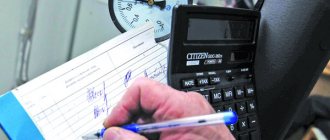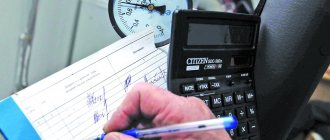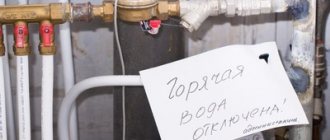Through State Services
To pay for cold and hot water on the State Services portal, you need to perform simple steps:
Go to the State Services service.- Go through authorization. To do this, enter your login in the upper field and the password specified during registration in the lower field.
- Next, at the top of the monitor, click “Service Catalog”.
- A page with categories will appear, on which you should click on the link “Apartment, construction, land.”
- Then click “Payment for housing and communal services”.
- Read the terms and conditions under which the service is provided. Then find the inscription “Get a service” on the right side of the screen and click on it.
- A list of organizations will appear; you need to click on the one that is listed on your payment receipt.
- If the required company is not listed, check the region at the top of the page, after the inscription “Search for bills for housing and communal services”. If it is defined incorrectly, you should correct this by clicking on the region name and selecting it manually. If the required supplier does not appear in the list even after specifying the region, this means that it is currently impossible to make a transfer to him through the State Services portal, and you will have to use another payment service.
- After the desired company appears on the screen, click on it with the mouse cursor, marking it with a green checkmark.
- Enter the sequence of numbers of your personal account below and click “Next”.
- A page will open indicating the debt and a field for entering the amount to be paid. Fill it out and click “Next”.
- On the page that opens, select a payment method.
- Enter the details of the credit card from which to withdraw funds and click “Continue”.
- The bank page will open, where you will need to write the password from the message sent to the mobile number.
- After entering the password and confirmation, the required amount will be debited from the card and the invoice will be paid.
Calculation of water consumption by meter
Water meters count the volume of water flowing through them over the entire period of operation.
Therefore, water consumption for the billing period is calculated by simply subtracting the numbers of previous readings from the numbers of new readings.
For example, your cold water meter measured 10523.849 (rounded to 10524 m3).
Last month you took readings of 10509.691 (rounded to 10510 m3).
Subtract 10510 from 10524 last month, we get 14 m3 of cold water.
We multiply the volume of consumption by the tariff 14x38.70 = 541.8 rubles.
This is exactly how much you will have to pay for water according to your receipt.
General house needs
In the Rules for the Provision of Public Utilities, outlined in Decree of the Government of the Russian Federation No. 354, in addition to payment for the consumption of cold and hot water on apartment meters, the category “common house needs” (CHN) is prescribed, for which payment is also charged.
Water consumption for one water pumping station consists of:
- watering front gardens and lawns near the house;
- washing staircases, common areas in entrances;
- waste of water during repairs;
- water consumption during repair of heating systems.
Tariffs and consumption standards for general household needs are approved by regional authorities and published both in official sources and on the websites of management companies.
If apartment buildings are equipped with individual and common building water meters, then the ODN is calculated as the difference between the flow rate calculated by the common building meter and the flow rate for all individual water meters.
The distribution of ODN expenses among residents is proportional to the area of their apartments.
Since 2021, payment for one-time tax has been moved in receipts from the “utilities” column.
Using Sberbank Online
In this case, to transfer payment for water, you can work through the mobile application, or go to https://online.sberbank.ru
Next you need to do the following:
Log in to Sberbank Online.- Click on the “Payments” link.
- Select the housing and communal services category.
- Press the “Water supply” button.
- Next, click on the company providing the service.
- Enter your individual account number and select the card from which the money will be debited. You can scan the QR code shown on the receipt, and then all the data will be entered automatically.
- After specifying your personal account, a page with fields for entering meter readings will open. Here you can enter the required data in accordance with the receipt and then click “Continue”. It is not necessary to enter meter readings into Sberbank Online. You can immediately click on the “Continue” inscription.
- On the next page, indicate the amount you need to pay. And click the “Continue” link again.
- Next, check that the receipt is filled out correctly and confirm the transaction by clicking on the appropriate link.
Visual instructions for payment in the video:
How to take readings from the meter
The water meter has eight rollers with numbers.
Five black and three red. For example, initially the counter showed the following data: 00000174. Here 174 is the number of liters of water used. As you know, readings must be taken in cubic meters, so it is too early to transmit them. In other words, the readings from the meter are taken based on the first five digits, so you can wait a month.
A month later, look again - the readings are already different: 00001174. In this case, they can already be taken, because there are more than three digits. It turns out that you use a little more than 1 cubic meter of water per month. When sending indicators, the amount is rounded, you pay only per cubic meter. Another month later we see on the water meter: 00012566. Now it turns out that 12 cubic meters were used. Subtract 12-1=11. This month you pay for 11 cubic meters of water.
Website of the water supply organization
To pay for water through the website of a water supply organization, you need to enter the name of this company in the search bar of your browser. You can find it on your payment receipt.
Next, in the search results, select the official website of this company and, by going to it, follow the steps:
Find a link leading to the payment page. It may be called “Payment”, “Payment of bills”, etc. Click on it and go to the required subsection.- In the empty fields, enter the required information: full name, address, individual account, meter readings, amount to be paid. All this data is taken from the receipt.
- Next, select a convenient payment method and go to the bank’s payment page.
- Enter card details.
- Click "Pay". A code will be sent to your mobile phone with which you need to confirm the payment transaction.
- Click "Confirm".
Yandex money
The Yandex.Money payment platform is equipped with a simple, intuitive interface, so it is often used when paying for utility services, including water. To make a payment you need to follow the link.
Follow these six simple steps:
- At the top of the page, click “Payment for services.”
- Select the category "Housing and Public Utilities".
- In the search bar of the site, enter the name of the company to which the payment is made, or its Taxpayer Identification Number.
- Click on the desired organization.
- On the page that opens, fill in all the required fields in accordance with the information indicated on the receipt. Check the correctness of the current account to which the money will be transferred. The correct one will be the one written on the receipt.
- Click the “Pay” button.
Good to know: When paying for water, you can use points accumulated on Yandex.Wallet. They can reimburse up to 50% of the amount.
Blog
On the issue of recalculation: who, for what, when and how much...
This article was written especially for employees of the Civil Housing Inspectorate and the prosecutor’s office. The main idea that we will try to reveal is that the word “recalculation” must be used carefully, because in Rules No. 354 not everything is obvious.
So, introductory
: apartment building, management organization,
direct contracts
for utilities,
lack of circulation
in the intra-building hot water supply system. Let's look at the step-by-step development of the situation in this case.
1.
A resident of one of the apartments calls the RSO emergency dispatch service (
as provided for in paragraph 105 of Rules No. 354
) and reports that ice water is running from the “hot tap”.
2.
The dispatcher finds out the information
required by virtue of clause 106 of Rules No. 354
.
3.
If the ADS RSO dispatcher knows in advance that in this case the reason is precisely the lack of circulation, he is obliged to report this and note this fact in the log (
paragraph 107
), and then be sure to inform the management organization that there is a corresponding request from a resident (
paragraph second paragraph 107
).
4.
If the ADS RSO dispatcher does not know the reasons for the violation of the quality of hot water supply, he:
A)
coordinates with the consumer a check not in the apartment, but
at the network interface
(
paragraph two of clause 108
), no later than two hours from the moment of application, unless another time is agreed upon with the consumer (
paragraph three of clause 108
);
b)
informs the management organization about the date and time of the inspection.
5.
There should be a description of how exactly the check is carried out at the network interface, but Rules No. 354 do not contain specifics in this regard, and therefore you should refer to clause 5 of Appendix No. 1 to Rules No. 354, where temperature is indicated as a required parameter for the quality of hot water supply .
It should be understood that in the situation under consideration, the “ water point
"
is not on the network interface
, which is why the problem occurs.
The consumer does not know (and does not care for him) what the temperature of the hot water supply is at the interface between the DSO networks and the networks served by the management organization. He appeals to the RSO ADS with a complaint that in his apartment
, instead of hot water from the tap, which should be no lower than 60 ° C and no higher than 75 ° C (
clause 2.4 of SanPiN 2.1.4.2496-09
), water runs from the tap, the temperature of which
according to his subjective feeling,
it is lower than required. The consumer has no complaints about the DHW temperature at the entrance to the house...
Please note: “ water point
“This is the concept of Rules No. 354, and in clause 2.4 of SanPiN 2.1.4.2496-09 the concept of “
water collection point
” is used.
Only in sub. “b” clause 4.9 SP 30.13330.2012 “Internal water supply and sewerage of buildings” ( which in clause 5.1.2 directly refers to the above SanPiN 2.1.4.2496-09
) you can read that the place of water collection is
a sanitary fixture
.
A small note
: clause 5.2.5 SP 30.13330.2012 established that in centralized hot water supply systems, if it is necessary to maintain water temperature in places of water collection not lower than that specified in 5.1.2, a
hot water circulation system should be provided during the period of no water collection
. In hot water supply systems with time-regulated consumption of hot water, it is allowed not to provide hot water circulation if its temperature at the points of water intake does not drop below that established in clause 5.1.2.
It should be understood that clause 4 of Appendix No. 1 to Rules No. 354 establishes uninterrupted 24-hour ( i.e. unregulated)
) hot water supply as a required quality parameter for hot water supply. Accordingly, the hot water circulation system is objectively necessary to maintain the temperature.
Let's get back to the topic. Inspection at the network interface is not covered by Rules No. 354, and this is more or less logical, since it would be optimal to stipulate the inspection mechanism in the agreement between the RSO and the management organization. In the end, with direct contracts between the population, the managing organization retains the interest in monitoring the quality of the supplied resource, at least in terms of the SOI CR.
The author of the article does not see any other way to carry out verification other than a two-stage one:
- checking at the network interface
(RSO is directly interested); - check at the point
(location)
of water collection
, that is, in the consumer’s apartment (the consumer is directly interested).
Accordingly, a violation of the quality of public services recorded in the inspection report ( clause 109
) cannot be confirmed or refuted only by checking at the network interface; it is necessary to measure the temperature of the hot water supply directly at the point of water collection.
Pay attention to the second paragraph of clause 109 of Rules No. 354: “ If during the inspection it is established that the quality of the utility service has been violated...
" How to understand it in the case of a direct RSO agreement with consumers?
If the temperature at the network interface is normal, but in the apartment it is below normal, this is a violation of the quality of the utility service. Why? Because this is stated in clause 5 of Appendix No. 1 to Rules No. 354. There are no reservations in the case of direct contracts
. The consumer has the right to receive hot water supply at a temperature not lower than 60°C and not higher than 75°C, regardless of who is providing the utility service.
Accordingly, the hot water supply is either below 60°C or above, and in this case no examination is required, that is, there is no need to check anything further on the basis of paragraph four of clause 109 and paragraphs one to five of clause 110 of Rules No. 354.
6.
If the consumer, the RSO and the management organization did not initiate the examination and did not agree on the fact of a quality violation and (or) the magnitude of the deviation of the parameters, then a repeat inspection is scheduled
with the participation of a representative of the GZHI and the public association of consumers
.
7
. The consumer receives a copy of the act, which indicates the fact of violation of the quality of the hot water supply in terms of temperature (let's call it act A).
Unilateral activation by the consumer and the subtleties of determining the start and end periods for the provision of utility services with a violation of quality ( clauses 110.1-113 of Rules No. 354
) are not considered within the scope of this article.
The second document that the consumer receives is called an act on the results of an inspection based on the results of eliminating the causes of violations of the quality of the utility service (act B).
8.
The consumer applies for recalculation to the contractor (in the RSO).
During the period between A and B,
does the consumer have the right to expect a reduction in the amount of payment for a poorly provided hot water service?
This is what is said verbatim in paragraph 103 of Rules No. 354:
«If the contractor is a resource supplying organization
which, in accordance with the agreement containing provisions on the provision of utility services, does not provide maintenance of in-house engineering systems, then such organization
changes the amount of payment
for utility services in the event
that a violation of the quality
of utility services and (or) interruptions in the provision of utility services
occur to the interface between
elements of in-house engineering systems and centralized networks of engineering and technical support.
In this case, if the quality violation
utility services and (or) interruptions in the provision of utility services exceeding their established duration
have arisen in in-house engineering systems
, then
the amount of payment
for utility services
is not
, and consumers
have the right
to demand
compensation for losses caused to them
, including those caused
by payment
for non-provided utility service or utility service of inadequate quality from persons engaged by the owners of premises in an apartment building or the owners of residential buildings (households) to service in-house engineering systems.”
The first paragraph of clause 103 directly indicates that RSO is obliged to make a recalculation
(
according to clause 5 of Appendix No. 1
)
only if
the temperature at the interface between the networks does not correspond to the required one.
Accordingly, RSO refuses recalculation in the situation under consideration.
9.
The second paragraph of clause 103 of Rule No. 354 states that if the quality of the hot water supply is compromised within the boundaries of the networks for which the management organization is responsible, then:
- the consumer pays for hot water supply in full
(and recalculation of RSO is rightfully refused); - the consumer has the right
compensation for losses
from the management organization .
It follows from this that a declarative procedure
for compensation of losses has been established, that is, the management organization
is not obliged to independently
calculate the amount of losses and compensate them on its own initiative.
From paragraph 2 of Art. 15 of the Civil Code of the Russian Federation, we remember that losses mean expenses that a person whose right has been violated has made or will have to make to restore the violated right, loss or damage to his property (real damage), as well as lost income that this person would have received if normal conditions of civil transactions, if his right had not been violated (lost profits).
At first glance, losses can be called the consumer's expenses for paying the full cost of the volume of hot water that he actually received of inadequate quality, but this is an incorrect judgment
.
The fact is that the reduction in the size of the board in case of violation of the quality of the hot water supply in terms of temperature does not occur to zero
necessarily and unconditionally; There is a description of how the fee is reduced in clause 5 of Appendix No. 1 to Rules No. 354:
“for every 3°C deviation from the permissible deviations in hot water temperature, the amount of payment for utility services for the billing period in which the specified deviation occurred is reduced by 0.1 percent of the fee determined for such billing period in accordance with Appendix No. 2 to the Rules , for each hour of deviation from permissible deviations in total during the billing period, taking into account the provisions of Section IX of the Rules.
For each hour of supply of hot water, the temperature of which at the point of analysis is below 40°C
, in total during the billing period, payment for consumed water is made
at the tariff for cold water
.”
We see that the fee after its reduction will never be equal to zero
. First, the reduction in the payment for hot water is calculated to a temperature below 40°C, and if in fact the temperature is below 40°C, then no further reduction occurs, and the payment is made according to the tariff for cold water.
The result is the amount that the consumer is obliged to pay for hot water supply at the wrong temperature.
Accordingly, the losses will be the difference
between the full cost
of hot water supply (which the consumer has actually already paid to RSO) and the resulting
reduced fee
, which the consumer is obliged to pay according to Rules No. 354.
10.
There should be a description of how the management organization compensates for losses.
But since Rules No. 354 do not regulate this point (and the mechanism established by Rules No. 491 does not work in this case - there will be a separate article about this
), we will limit ourselves to three pieces of advice:
A)
since the management organization, by virtue of the direct indication of paragraph six of clause 113 of Rules No. 354, participates in the inspection and has in hand both an inspection report and a report on the results of the inspection based on the results of eliminating the causes of violation of the quality of the utility service, it
has the opportunity to calculate in advance
the amount of losses for for which the consumer has the right to apply for compensation;
b)
in the case of a corresponding request from the consumer
you should not waste time
, you need to evaluate the amount claimed for compensation (compare with your calculation) and pay it, otherwise the consumer has the right to demand interest for the use of other people’s money under Art. 395 Civil Code of the Russian Federation;
V)
if the amount of losses claimed for compensation is clearly overstated, the management organization
has the right to compensate for losses in the amount that it considers justified
(of course, in the response to the appeal you should indicate this fact and be prepared for the fact that a claim will be filed).
PS
: Always ready for a discussion (even anonymous) with representatives of the State Property Committee and the prosecutor’s office.
Qiwi wallet
Through a QIWI wallet you can make a payment without commission, going through 7 steps:
Go to the QIWI website- Click on the “Payments” button, which is located at the top of the screen.
- At the very bottom of the next page, find the Utility Payments section, click on it and go to the page of companies providing services.
- Next, in the search bar, enter the name of the desired company or its TIN.
- In the list that appears, select your company and go to the data entry page.
- In the appropriate fields, enter your personal number and payment amount, select a convenient payment method.
- Next, click “Pay.”
Features of payments for water supply in a communal apartment and a private house
Calculation of utility services for owners of private houses, apartments and SNT has its own characteristics.
The owner of the communal apartment pays the amount calculated according to the meter and established tariffs.
In addition, the subscriber is charged for the supply of general housing needs - watering lawns, cleaning entrances.
But the private owner does not pay the common house interest. But he is charged an amount for turning off the water supply in the riser - in storey buildings this service is usually included in the general maintenance of the house.
EIRC website
EIRC is an organization created with the goal of accumulating all payments for housing and communal services so that citizens can pay for all utilities at once and in one place.
Payment terms for different EIRC services vary . For some, it is possible to make a payment without registration, for others, you will have to go to your personal account, such as, for example, mosobleirts.rf.
As for the commission, conditions here also vary in different cities. Some payment centers offer to pay for water without interest. Others take not only a percentage, but also an additional fixed amount, such as at the EIRC of the Krasnodar Territory.
Each region has its own EIRC website, but, in general, the principle of action for payment is approximately the same:
- Go to the website of the EIRC in your region.
- Find the “Pay” button and click on it.
- Enter the information from the receipt that you have on hand.
- Select a convenient method for depositing money and click “Pay”.
- Next, confirm the payment using the SMS code.
Information! The advantage of such portals is that it is possible not only to pay charges in full for all housing and communal services, but also to transfer data from meters, as well as check all charges on a personal account.
What do you need to pay by the meters?
If water meters are not installed, they must be installed. The installation procedure is quite simple, but if you are not a specialist, in order to save time, it is better to trust those who have performed such work not for the first time.
In the capital, it will not be difficult to find a specialized company that has the appropriate certificate, and you will not have problems with the engineering service when registering devices. Competition in the installation sector of water meters in Moscow is quite high, there are many offers, the price level does not differ much, and the cost of installation will not be excessive.
"All payments" website
Another convenient and, therefore, popular site for paying for housing and communal services is the Internet resource “All Payments”. His Internet address is: vp.ru.
There is no need to register here:
- Enter the company name.
- Click on the desired organization and enter the information from the receipt.
- Click the “Pay” button.
- Enter your bank card details.
- Confirm the operation with the code from SMS.
The presence or absence of a commission on this site depends on which specific company transfers money.
Changing the position of housing and communal services providers
It may happen that at one point, providers of housing and communal services will not want to work with citizens directly and will begin to present all their claims related to non-payment to the HOA or management company. This is what happened in this case. Service providers began to demand payment from the HOA for the resources supplied to the houses.
And so the matter came to court. Arbitration courts recovered first from the HOA, and then from the management company in favor of housing and communal services service providers, debts for the supplied resource to the houses they managed.
Internet banking
It is possible to pay water charges not only using Internet banking from Sberbank. Other banking organizations also have similar services:
To pay through Alfa-Bank you need:
- Go through authorization.
- Select "Payments".
- Go to the “Utility Payments” category.
- Click “Select company”.
- Enter the name or TIN of the organization to which you are making payments.
- Enter your personal account and amount.
- Click the “Continue” link.
- Check the entered information and confirm the payment.
Via Tinkoff Internet Bank:
- Go to the user's account.
- Click the link at the top of the Payments page.
- Select your company from the list that appears. If it is not in the list shown, then you can find it through the search bar.
- By going to the organization’s page, enter your individual number and the period for which the payment is made. On the same page, select the card from which funds will be debited, and also enter the amount to be paid. Then click “Pay”.
- On the next page, enter the confirmation code and transfer money.
Reference! Similar actions are carried out in other online banks: VTB, Post Bank, MKB, etc.
Do I need a license for a well on the property?
Ordinary summer residents can, without any permits, extract water from simple water intake structures (wells and small-diameter wells) located within their plot of land, which exploit the first aquifer from the surface. The main conditions are that groundwater must be extracted exclusively for one’s own needs in a volume of no more than 100 cubic meters per day.
Individuals cannot equip an artesian well. The extraction of artesian waters is the exploitation of subsoil resources that are registered with the state, therefore an artesian well must be licensed. It can only be collective.
The law on subsoil does not contain such concepts as “well” and “borehole”, so these structures can be considered only as ways of arranging water intake on the site. A summer resident can dig a well 5 meters deep on his property. And if there is no water at this depth, then you can dig deeper, but you need to know where the source of the centralized water supply in the given area is. You can't join him.
On what sites can I pay?
Below is a list of services that allow you to pay for water, heating and without commission.
By the address
to pay for water at an address only on two sites:
- Government services.
- Sberbank Online.
By personal account
You can pay for water supply, knowing your personal account, using:
- website of the water supply organization;
- EIRC website.
No commission
The resources listed below do not charge a percentage for payment:
- QIWI Wallet.
- Internet banking.
- Website of the water supply organization.
- State Services Portal.
- Sberbank Online.
Not only for cold water supply and hot water supply, but also for heating
If you need to pay not only for water, but also for heating, then you should use the services from the list:
- State Services Portal.
- Sberbank Online.
- Yandex Wallet.
- QIWI Wallet.
- EIRC website.
- "All Payments" website.
How to pay by receipt: step-by-step instructions
Payment for water is carried out in several ways. This can be done by the subscriber himself, by taking readings and calculating the amount. It can also be clarified in the housing and communal services, whose employees also monitor the installed meter.
By meter
If payment is made by meter, you must proceed in the following sequence:
- lift the meter cover;
- take a picture of the first black numbers on your phone - the red numbers are ignored, since they are in watts, liters;
- round off the taken figure - for example, 00005439 will mean 5.5 cubic meters;
- transfer the meter readings to the management company (via the official website) or the housing office (using the personal number of the inspector conducting the inspection) - do not forget to indicate the residential address or account number in the message.
Read how to correctly write off data from the meter here.
You can also submit your testimony by calling the EIRC. Some Russians, especially pensioners, still pay utility bills in person, being present at a bank, post office or at the cash desks of management or resource supply companies.
This method is long outdated. Now it is much faster and more profitable to do this via the Internet, with a payment receipt, Internet connection and any device for accessing the network - a smartphone, laptop, computer.
The service is provided by various services, but the most popular among the population is Yandex. money, Qiwi, websites of water supply organizations and ERIC (by region of residence).
Using Yandex and Qiwi as an example:
- go to the payments tab;
- find housing and communal services;
- enter the identification code of the water utility or select the organization from the drop-down menu;
- indicate the calculated data, amount;
- pay and confirm.
If there are no rubles in your Yandex wallet, you can also write off funds using a card.
On the official website of the water utility:
- open a category for payment;
- fill out the drop-down form - enter the code, subscriber’s name and meter readings;
- pay using one of the proposed methods.
Online payment allows you to save time and avoid standing in line at the post office. This is also a minimum of commissions, especially when transferring funds through electronic wallets or a Sberbank card.
Find step-by-step instructions for paying for hot water using a meter here, and general rules for paying for water supply with an installed IPU here.
Without counter
Water users who have not yet installed meters have to pay special, increased prices (for apartments at a coefficient of 1.5). Such payment is financially burdensome. There is no single law regulating water consumption per person.
Therefore, average consumption data is used, depending on the validity period. Tariffs for the resources used are set differently, depending on the region of the country. Approximately the calculation is for 800-1000 liters of water consumed per person per week.
If installing a meter is not planned, the owner can reduce costs for water supply by following the following instructions:
- send a request to the management company for employees to install a seal on one of the valves - if there are no residents in the house, no charges will be made;
- provide the organization with a certificate confirming the absence of the owners in the apartment for a certain period of time.
The payment itself is made in the same ways as when paying by meter - in person, through an ATM and via the Internet.









